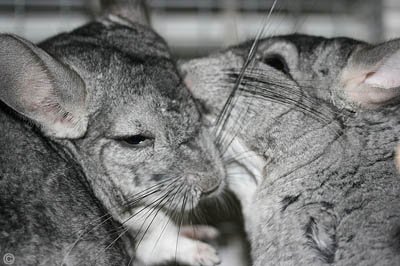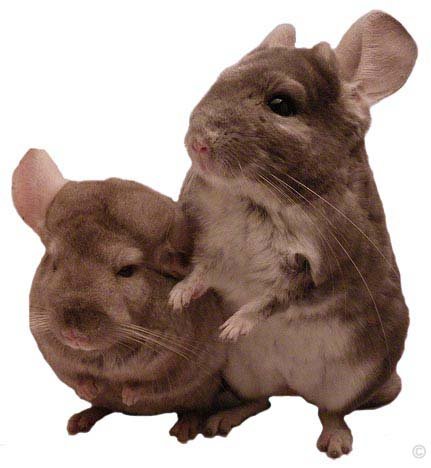 Breeding chinchillas is a serious responsibility so do not contemplate this task if you are uneducated on all the aspects regarding the breeding of chinchillas, the dangers and what to look out for together with full knowledge of chinchilla kits (babies).
Breeding chinchillas is a serious responsibility so do not contemplate this task if you are uneducated on all the aspects regarding the breeding of chinchillas, the dangers and what to look out for together with full knowledge of chinchilla kits (babies).
It is vitally important that you only ever breed chinchillas of good quality stock and have pre-arranged responsible homes for the chinchilla kits when they are ready to leave the maternal environment.
The chinchillas that you choose to breed must have no medical history that can be passed on to the unborn foetus and both parents must be of good weight with a prior healthy lifestyle before breeding commences.
Breeding chinchillas must never carry the lethal gene as this will expose both the mother and foetuses to unnecessary extra stress. By this we mean breeding White with White, TOV to any other TOV. Although offspring will still be produced, the lethal gene connected to these combinations, when bred together, will produce 25% less offspring. The surviving offspring will generally be weaker and of poorer health than the desired offspring you should be aiming for and extra vigilance and care will be needed to both the mother and kits both pre and post-partum.
Chinchillas should not be bred before 9 months old due to sexual immaturity and under development. This can cause extra stress on the chin-mum through pregnancy and birth and can also produce kits of a poor quality with additional underlying health issues.
Generally a female chinchilla will not breed until she is ready and this can take up to 2 years until she hits proper maturity. Until she is ready, she will fight the male off, by first vocalizing her distress before standing on her hind legs and spraying urine at him. If the male does not leave the female alone at this point, she will attack him, which can prove fatal to the male if he has no where to hide and get away. It is therefore essential that the chinchilla cage is big enough for both the chinchillas and potential offspring and there are plenty of 'bolt holes' when either chin needs 'time out' from the other.
 Female chinchillas come into season every 30-40 days after they have ejected a vaginal plug known as the 'Oestrus Plug'. After this time you will notice the male become more persistent than normal and he will frequently wag his tail, showing excitement, before chasing the female around the cage. The female will always show resistance to mating at first and will be quite vocal but eventually she will submit to breeding when she is ready.
Female chinchillas come into season every 30-40 days after they have ejected a vaginal plug known as the 'Oestrus Plug'. After this time you will notice the male become more persistent than normal and he will frequently wag his tail, showing excitement, before chasing the female around the cage. The female will always show resistance to mating at first and will be quite vocal but eventually she will submit to breeding when she is ready.
The actual mating process happens very quickly and can be quite aggressive with the male pulling at the female's fur, hence clumps of noticeable fur around the cage (this is natural). Chinchillas should not be separated during the breeding process unless you see the female turn and attack the male drawing blood in the process.
During the mating/breeding process a 'copulation plug' is formed, which is excreted from the female after breeding has finished. The copulation plug is a waxy substance surrounded by a cornified layer of the vaginal wall. The copulation plug is small (approximately 1" long) and hardens rapidly, drying on exposure to air. The plug is a  creamy colour and often missed by the owners when cleaning the cage.
creamy colour and often missed by the owners when cleaning the cage.
As chinchillas don't always breed right in front of you, it is important that the male is checked regularly and not just after you see chinchillas mating. The male must be examined to check that no hairs have become wound tightly around the penis or have become lodged under the foreskin, known as Hair Ring. Should this be the case and the fur is not removed, serious injury to the penis will occur, which can cause death to a male if not removed quickly.
Breeding Problems
Various breeding problems can occur especially in young inexperienced chinchillas or chinchillas that have underlying health issues. It is therefore important to examine any chinchillas you are planning to breed before they are allowed to mate together and ensure they are of optimum health to prevent any unnecessary breeding complications to arise.
Sterility can be a a problem in chinchillas that cannot conceive. Amongst other causes, this can be due to the breeding chinchilla being poorly nourished or there is an infection to the genital system.
Very rarely, the uterine tubes will not be open, the tube can become blocked through adhesions as a result of inflammation. Such a condition can also be the result of an infected uterus, caused by the death and necrosis of a mal-formed foetus, which is generally a result of breeding together two chinchillas that carry the lethal gene.
Mal-formed foetus will often be aborted by the mother but if not, blood poisoning or toxemia can develop or the fluids may be absorbed by the blood stream leaving the foetus skeleton to become mummified. Such a situation will cause major difficulties in fertilization because the sperm from the male cannot get through the blocked tube or horn of the female's uterus.
A poor diet for the breeding chinchillas may be such that it also leaves the chinchillas no desire to breed. Unbalanced rations, under feeding the proper nutrients, feeding too much of one kind of food and the feeding of poor quality hay and grasses interfere with both the female and males's fertility.
The main causes of infertility in chinchillas are:
- Genetic factors (especially those associated with breeding)
- Nutritional deficiencies
- Nonviable sperm
- Hormone imbalance
- Mummified foetus in uterus
- Too frequent breeding without sufficient rest periods between mating's/pregnancy.
- Metritis - Inflammation to the uterus.
If any chinchilla is having fertilization difficulties they must be taken to a veterinary surgeon for a full examination and x-ray of the abdomen region. If an infection is detected and treated soon enough a chinchilla will generally continue to conceive in future without any problems providing there has been no permanent damaged done.
The Chinchilla A-Z Health & Sickness Bible lists various causes of breeding difficulties and provides prevention methods against such ailments from happening. It is suggested that you read this eBook together with the booklets on Vitamins and Minerals if you are serious about chinchilla breeding as these books go into more detail with regards to what is needed for successful breeding.
Further Reading Relating To Chinchilla Breeding:
Birth, Chinchilla Anatomy, Chinchilla Babies (Kits), Chinchilla Care, Chinchilla Health, Chinchillas For Sale, Genetics, Male Castration, Minerals And The Relation To Chinchilla Disease, Nutrition (Food & Diet), Pregnancy, Pre & Post Natal Care, Supplementation, Vitamins And The Relation To Chinchilla Disease, Weaning.



 Breeding chinchillas is a serious responsibility so do not contemplate this task if you are uneducated on all the aspects regarding the breeding of chinchillas, the dangers and what to look out for together with full knowledge of chinchilla kits (babies).
Breeding chinchillas is a serious responsibility so do not contemplate this task if you are uneducated on all the aspects regarding the breeding of chinchillas, the dangers and what to look out for together with full knowledge of chinchilla kits (babies). Female chinchillas come into season every 30-40 days after they have ejected a vaginal plug known as the 'Oestrus Plug'. After this time you will notice the male become more persistent than normal and he will frequently wag his tail, showing excitement, before chasing the female around the cage. The female will always show resistance to mating at first and will be quite vocal but eventually she will submit to breeding when she is ready.
Female chinchillas come into season every 30-40 days after they have ejected a vaginal plug known as the 'Oestrus Plug'. After this time you will notice the male become more persistent than normal and he will frequently wag his tail, showing excitement, before chasing the female around the cage. The female will always show resistance to mating at first and will be quite vocal but eventually she will submit to breeding when she is ready. creamy colour and often missed by the owners when cleaning the cage.
creamy colour and often missed by the owners when cleaning the cage.